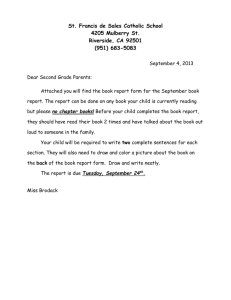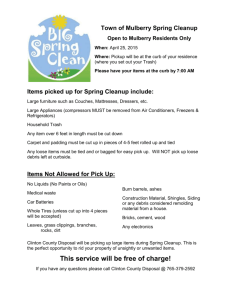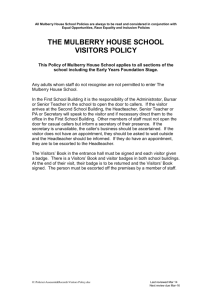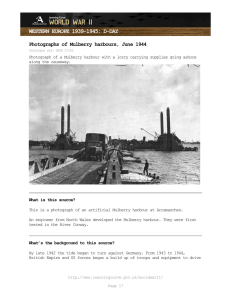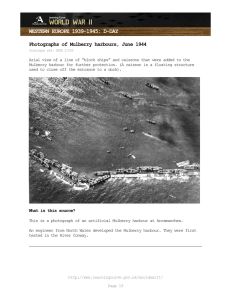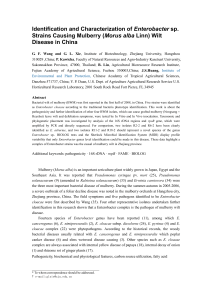Document 13309167
advertisement
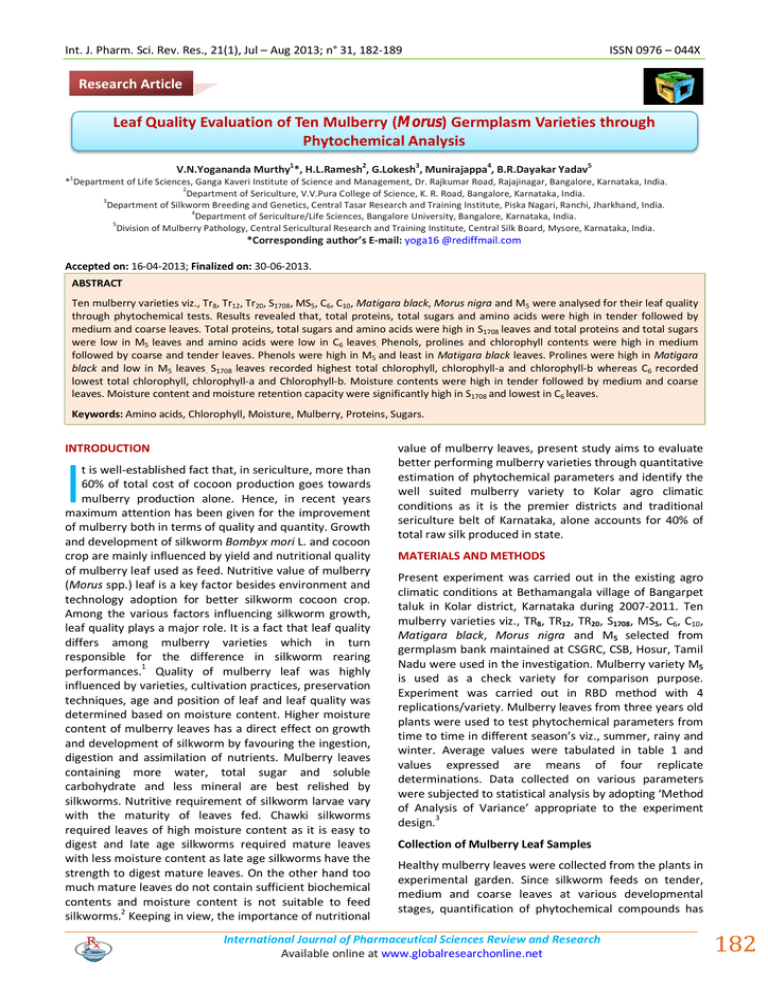
Int. J. Pharm. Sci. Rev. Res., 21(1), Jul – Aug 2013; n° 31, 182-189 ISSN 0976 – 044X Research Article Leaf Quality Evaluation of Ten Mulberry (Morus) Germplasm Varieties through Phytochemical Analysis 1 1 2 3 4 5 V.N.Yogananda Murthy *, H.L.Ramesh , G.Lokesh , Munirajappa , B.R.Dayakar Yadav * Department of Life Sciences, Ganga Kaveri Institute of Science and Management, Dr. Rajkumar Road, Rajajinagar, Bangalore, Karnataka, India. 2 Department of Sericulture, V.V.Pura College of Science, K. R. Road, Bangalore, Karnataka, India. 3 Department of Silkworm Breeding and Genetics, Central Tasar Research and Training Institute, Piska Nagari, Ranchi, Jharkhand, India. 4 Department of Sericulture/Life Sciences, Bangalore University, Bangalore, Karnataka, India. 5 Division of Mulberry Pathology, Central Sericultural Research and Training Institute, Central Silk Board, Mysore, Karnataka, India. *Corresponding author’s E-mail: yoga16 @rediffmail.com Accepted on: 16-04-2013; Finalized on: 30-06-2013. ABSTRACT Ten mulberry varieties viz., Tr8, Tr12, Tr20, S1708, MS5, C6, C10, Matigara black, Morus nigra and M5 were analysed for their leaf quality through phytochemical tests. Results revealed that, total proteins, total sugars and amino acids were high in tender followed by medium and coarse leaves. Total proteins, total sugars and amino acids were high in S1708 leaves and total proteins and total sugars were low in M5 leaves and amino acids were low in C6 leaves. Phenols, prolines and chlorophyll contents were high in medium followed by coarse and tender leaves. Phenols were high in M5 and least in Matigara black leaves. Prolines were high in Matigara black and low in M5 leaves. S1708 leaves recorded highest total chlorophyll, chlorophyll-a and chlorophyll-b whereas C6 recorded lowest total chlorophyll, chlorophyll-a and Chlorophyll-b. Moisture contents were high in tender followed by medium and coarse leaves. Moisture content and moisture retention capacity were significantly high in S1708 and lowest in C6 leaves. Keywords: Amino acids, Chlorophyll, Moisture, Mulberry, Proteins, Sugars. INTRODUCTION I t is well-established fact that, in sericulture, more than 60% of total cost of cocoon production goes towards mulberry production alone. Hence, in recent years maximum attention has been given for the improvement of mulberry both in terms of quality and quantity. Growth and development of silkworm Bombyx mori L. and cocoon crop are mainly influenced by yield and nutritional quality of mulberry leaf used as feed. Nutritive value of mulberry (Morus spp.) leaf is a key factor besides environment and technology adoption for better silkworm cocoon crop. Among the various factors influencing silkworm growth, leaf quality plays a major role. It is a fact that leaf quality differs among mulberry varieties which in turn responsible for the difference in silkworm rearing performances.1 Quality of mulberry leaf was highly influenced by varieties, cultivation practices, preservation techniques, age and position of leaf and leaf quality was determined based on moisture content. Higher moisture content of mulberry leaves has a direct effect on growth and development of silkworm by favouring the ingestion, digestion and assimilation of nutrients. Mulberry leaves containing more water, total sugar and soluble carbohydrate and less mineral are best relished by silkworms. Nutritive requirement of silkworm larvae vary with the maturity of leaves fed. Chawki silkworms required leaves of high moisture content as it is easy to digest and late age silkworms required mature leaves with less moisture content as late age silkworms have the strength to digest mature leaves. On the other hand too much mature leaves do not contain sufficient biochemical contents and moisture content is not suitable to feed 2 silkworms. Keeping in view, the importance of nutritional value of mulberry leaves, present study aims to evaluate better performing mulberry varieties through quantitative estimation of phytochemical parameters and identify the well suited mulberry variety to Kolar agro climatic conditions as it is the premier districts and traditional sericulture belt of Karnataka, alone accounts for 40% of total raw silk produced in state. MATERIALS AND METHODS Present experiment was carried out in the existing agro climatic conditions at Bethamangala village of Bangarpet taluk in Kolar district, Karnataka during 2007-2011. Ten mulberry varieties viz., TR8, TR12, TR20, S1708, MS5, C6, C10, Matigara black, Morus nigra and M5 selected from germplasm bank maintained at CSGRC, CSB, Hosur, Tamil Nadu were used in the investigation. Mulberry variety M5 is used as a check variety for comparison purpose. Experiment was carried out in RBD method with 4 replications/variety. Mulberry leaves from three years old plants were used to test phytochemical parameters from time to time in different season’s viz., summer, rainy and winter. Average values were tabulated in table 1 and values expressed are means of four replicate determinations. Data collected on various parameters were subjected to statistical analysis by adopting ‘Method of Analysis of Variance’ appropriate to the experiment design.3 Collection of Mulberry Leaf Samples Healthy mulberry leaves were collected from the plants in experimental garden. Since silkworm feeds on tender, medium and coarse leaves at various developmental stages, quantification of phytochemical compounds has International Journal of Pharmaceutical Sciences Review and Research Available online at www.globalresearchonline.net 182 Int. J. Pharm. Sci. Rev. Res., 21(1), Jul – Aug 2013; n° 31, 182-189 been carried out in tender, medium and coarse leaves separately. Leaf samples collected were washed thoroughly with tap water followed by distilled water, then wiped and dried under shade followed by oven ° ° drying at 60 C-65 C till constant weight was attained. Completely dried leaf samples were pulverised separately and used for analysis. Total Proteins Total proteins were measured using Folin-phenol 4 reagent. 50mg of dry leaf powder was homogenised in 80% ethanol using mortar and pestle and homogenate was centrifuged at 5000rpm for 20 minutes. Supernatant was discarded and pellet was suspended in 10ml of 10% trichloro acetic acid (TCA) for 30minutes to precipitate proteins, centrifuged at 5000rpm for 10minutes and supernatant was discarded. Pellet was then washed with 5%TCA to remove interfering amino acids and phenols. Protein precipitate was then dissolved in 1N sodium hydroxide by allowing for 30minutes in hot water bath. Extracted proteins in 1N NaOH were diluted 10 times with distilled water. 1ml of protein sample was taken in a test tube, 5ml of alkaline copper reagent was added. Mixture was allowed to stand at room temperature for 10 minutes. 0.5ml of folin-phenol reagent was rapidly added and mixed. After 30 minutes absorbency was measured at 750nm. Protein content was calculated by preparing standard curve with bovine serum albumin (BSA). Total Sugars Total sugars were estimated using anthrone reagent.5 25mg of dry leaf powder was crushed thoroughly in 10ml of hot ethanol using a mortar and pestle. The leaf tissue was exhaustively extracted twice or thrice using small quantity of ethanol cooled and filtered through a whatman filter paper. The final volume of filtrate was made to 10ml either by adding or evaporating the ethanol. 1ml of ethanol extract was pipetted into a test tube and 4ml of anthrone reagent was added and mixture was incubated at 100°C in a boiling water bath for 10minutes. Then mixture was removed, cooled to room temperature in running water, and absorbance of resultant blue-green solution was measured at 625nm. Amount of sugar present in the extract was calculated using a standard curve prepared from glucose. Amino Acids Amino acids were measured by modified ninhydrin method.6 50mg of dry leaf powder was homogenised in 5ml of 80% methanol using mortar and pestle. Homogenate was centrifuged at 5000rpm for 10minutes. The supernatant was partitioned with an equal volume of petroleum ether in order to remove chloroplast pigments. The methanolic layer was used for amino acid estimation. 1ml of sample was taken in a test tube, to which 0.5ml of 0.2M methyl cellosolve ninhydrin solution was added and reaction mixture was kept over a boiling water bath for 20minutes. Later, it was cooled under running water. Volume of the reaction mixture was made up to 5ml with ISSN 0976 – 044X 60% ethanol reagent and absorbance was measured at 570nm. Amount of amino acids were calculated using a standard curve prepared with glycine. Phenols Phenols in fresh leaf were estimated by standard method.7 100mg of leaf sample was extracted with 10ml of distilled water in a clean mortar and pestle. Homogenate was centrifuged at 3000rpm for 20 minutes; supernatant was collected and used for analysis. To 1ml of the extract, 1ml of folin-phenol reagent was added followed by 2ml of 20%sodium carbonate solution. Mixture was shacked vigorously and placed on boiling water bath for one minute, then cooled under running water. Solution was diluted with distilled water to make up the volume to 25ml and optical density was measured at 650nm and Caffeic acid was used as standard. Prolines 8 Prolines were estimated by standard method. 200mg of dried leaf powder was homogenised in 3% sulphosalycillic acid and mixture was filtered through whatman No.1 filter paper. Filtrate was made up to 10ml by adding 3%sulphosalycillic acid. 2ml of filtrate was pipetted into test tube and 2ml of glacial acetic acid and 2ml of acid ninhydrin regent was added. Mixture was kept in a boiling water bath for 1hour. Then cooled to room temperature, add 4ml of toluene and mixed thoroughly. Finally colorless fraction was discarded and intensity of scarlet color formed was measured at 520nm. Proline content was calculated using the following equation. 35.892 x optical density x volume of the extract = g/g Volume of sample x weight of tissue (g) Where 35.892 is factor derived from standard curve for pure proline. Chlorophyll Content Total chlorophyll contents from fresh mulberry leaves without maceration were determined using Dimethyl sulphoxide (DMSO).9 50mg of leaf tissue was taken in a test tube and add 7ml of DMSO to it and kept the mixture in an electric oven for 3 hours at 65°C. Finally, extract was transferred to a measuring cylinder and made up volume to 10ml with DMSO and assayed immediately or transferred to vials and stored below 4°C until required for analysis. Estimation of Chlorophyll Content Total chlorophyll, chlorophyll-a and chlorophyll-b contents were estimated.10 3ml of chlorophyll extract was transferred to a cuvette and optical density was recorded at 645nm and 663nm against DMSO blank in systronics105 (MK-1) spectrophotometer. Chlorophyll contents were calculated using following equations. International Journal of Pharmaceutical Sciences Review and Research Available online at www.globalresearchonline.net 183 Int. J. Pharm. Sci. Rev. Res., 21(1), Jul – Aug 2013; n° 31, 182-189 ISSN 0976 – 044X Leaf moisture retention (%) = 100 - Leaf moisture loss protein is a major determinant of nutrient quality for many Lepidopteron larvae. It is known fact that, nearly 70% of protein content of raw silk namely fibroin and sericin are directly biosynthesized from mulberry leaf protein and remaining 30% is derived from silkworm body tissue and haemolymph protein, emphasizing the importance of leaf protein in silkworm nutrition.16-18 Protein content present in different mulberry varieties had a direct bearing on larval growth particularly in silk 19 gland development and cocoon characters of silkworm. Similar studies were conducted and observed a significant varietal difference in protein content.20,21 Biochemical composition of eight different mulberry varieties leaves S54, C1, MR2, Kitchili, Roso, Kosen, Japanese and M5 indicated variation in total protein content. However, except C1 and MR2 varieties other varieties did not showed significant variations.22 14 selected mulberry germplasm varieties also established maximum protein content in tender leaves which gradually depleted in medium and coarse leaves. Similar observations were also reported on different mulberry varieties.23,24 Same trend was observed in present investigation. Studies on diploid and triploid mulberry varieties revealed that, higher crude protein content in triploids than diploids and also recorded variations in total protein content in many mulberry varieties.25,26 6 mulberry varieties were evaluated and results revealed that, S1635 variety recorded highest leaf protein (26.91%) content.27 Proteins were higher in BC259, S30, S36, S41 and C1 varieties among the selected mulberry varieties.28 TG mulberry variety had high protein content (23.58%) followed by DD (23.57%) and minimum in Jatinuni (19.92%) among the 23 elite varieties evaluated.29 Maximum protein content was observed in mulberry variety Chak majra and minimum in Sujanpur variety.30 RESULTS AND DISCUSSION Total Sugars Deficiency or imbalance of plant nutrients in mulberry leaves causes changes in the metabolic activity of silkworm larva. Nutritional contents of mulberry leaf greatly influence the growth and development of silkworm larvae, which in turn affects the quality and quantity of silk production.12,13 Leaf quality is an important parameter used for evaluation of mulberry varieties while selecting best varieties for silkworm rearing and biochemical composition of mulberry leaves varies depending on variety, season, soil, water and 14,15 cultural practices. Total sugar content was found to vary both in respect of leaf maturity and varieties studied. Tender leaves of S1708(16.02%) recorded highest total sugars followed by Tr12(15.05%) and lowest in C6(10.85%). In medium leaves also similar trend was noticed. Highest was noticed in S1708(14.10%) followed by Tr12(13.52%) and less in C6(9.73%) leaves. Course leaves of S1708(11.74%), Tr12(11.11%) and Tr8(10.73%) recorded significantly higher level of total sugars lowest was recorded in C6(8.02%) leaves (Table 1). Sugars play an important role in determining the quality of leaf that in turn influence healthy growth and development of silkworms. Sugars are utilized as the main source of energy apart from inducing the silkworms to bite the leaves (biting factor) and cherish it well. Tender leaves of S54 mulberry genotype showed higher total sugar content (13.05%) when compared to M5 genotype (10.95%). Maximum total sugar content was recorded in tender leaves of 14 mulberry genotypes, which gradually declined with increasing growth periods and maturity levels. Higher sugar content in tender leaves could be attributed to the translocation of more photosynthetic products to upper 20.2 (D 645) + 8.02 (D663) x1000 x weight of leaf (g) Total chlorophyll = = … mg/gram V (12.7 x D663) - 2.67 x D645) x 1000 x weight of leaf (g) Chlorophyll-a = = … mg/gram V (22.9 x D645) - (4.68 x D663) x1000 x weight of leaf (g) Chlorophyll-b = = … mg/gram V Where V = Volume of the extract, D = Optical density. Where V = Volume of the extract, D = Optical density. Determination of Leaf Moisture Content and Moisture Retention Capacity Leaf moisture content and moisture retention capacity 11 were determined on fresh weight basis. For each maturity, 25 leaves/replicate/variety were harvested separately from a longest shoot and leaves were wiped with a muslin cloth to remove dust particles and fresh weight was recorded immediately. Then leaves were kept in normal environmental conditions (26°C1°C temperature; 70%5% relative humidity) for 6hours. After 6hours, leaves were weighed for calculating water retention capacity. Then leaves were dried in hot air oven at 80°C for 48hours till constant weight was attained and dry weight was recorded. Leaf moisture content of tender, medium and coarse leaves was calculated separately by using following formula and expressed in percentage (%). Fresh weight of leaves - Dry weight of leaves Leaf moisture content (%) = X100 Fresh weight of leaves Leaf moisture retention capacity was calculated by using following formula and expressed in percentage (%). Fresh wt. of Leaves – Wt. of leaves at 6 hours after harvest Leaf moisture loss (%) = X LMC Fresh weight of leaves Total Proteins Total proteins in tender leaves of S1708(27.31%) and Tr8(25.81%) recorded higher values and significantly lower in M5(15.91%) tender leaves. In medium leaves S1708(20.92%) followed by Tr8(20.10%) recorded highest protein content, did not differ significantly. M5(12.94%) variety medium leaves revealed lesser protein content. Protein content was found highest in coarse leaves of S1708(15.58%) followed by Tr8(13.50%), and least was recorded in C6(10.14%) and M5(9.84%) (Table 1). Leaf International Journal of Pharmaceutical Sciences Review and Research Available online at www.globalresearchonline.net 184 Int. J. Pharm. Sci. Rev. Res., 21(1), Jul – Aug 2013; n° 31, 182-189 leaves (actively growing) than lower leaves and sugar depletion among varieties of different maturity levels could be attributed to genotypic characters. Similar observations were also noticed in the present investigation. Highest percentage of total sugars was recorded in S41 variety compared to other five indigenous varieties studied. S54 mulberry leaves contain more amount of total sugars compared to K2 variety leaves.31 Soluble sugar contents were higher in Kitchili and Japan varieties followed by S54 and M5 mulberry varieties. Maximum total sugar content was found in Kairyoroso, an exotic variety among 7 mulberry varieties and also it was observed that, total sugars decrease with increased maturity of leaves from top to bottom.32 Study reported that, maximum percentage of sugars in Chinese white variety and minimum in Sujanpur variety. It was observed that, maximum leaf sugar content in OPH3 (11.60%) followed by Ber. C799 (11.28%) while minimum was found in Sujanpur5 (9.22%). Mulberry variety S1635 (12.44%) showed maximum sugar content when compared to S13, S34, S1, Vishwa and Mysore local varieties. It was recorded that, mulberry variety S1708 under 60cm x 60cm plant spacing showed maximum leaf sugar content among all the varieties studied. Exotic mulberry cultivar S799 had highest total sugars (12.66%) when compared to the varieties studied.33 It was observed that, total sugar content was significantly higher in S36 mulberry variety among the taxa studied.34 Amino Acids Amino acids recorded highest in tender leaves of mulberry variety S1708 (68.43 mole/g) followed by Tr8 (64.90 mole/g) and lowest in C6 (45.94 mole/g) leaves. Significantly highest amino acids were noticed in medium leaves of S1708 (69.97 mole/g) followed by Tr8 (59.83 mole/g) and lowest in C6 (42.02 mole/g) leaves. In course leaves, amino acid was highest in M5 (33.11 mole/g) followed by S1708 (33.01 mole/g), Tr8 (27.80 mole/g), MS5 (27.71 mole/g), C10 (26.17 mole/g), Tr12 (25.60 mole/g), Tr20 (23.87 mole/g), Morus nigra (23.04 mole/g), Matigara black (22.52 mole/g) and lowest was recorded in C6 (21.88mole/g) (Table 1). Mulberry leaves are quite rich in amino acid content (18.6%), forms an important constituent for silkworm 35,36 nutrition. Considerable amount of amino acids utilised for the formation of haemolymph, development of silk glands and cocoon production. Amino acids are important 37 for phytophagous insects help them in food selection. 12 mulberry genotypes were examined and results revealed that, there was no significant difference among the genotypes except a marginal difference of amino acid content in BC259, S30, S36 and G5 mulberry genotypes (20.44mg/g-24.23mg/g). It was observed that, when mulberry genotypes are grown under drought condition, free amino acid contents varied among the genotypes.38 Higher amount of free amino acid content recorded in S34 variety compared to other varieties studied. It was observed that, a significant difference in free amino acid content in S54 and MR2 varieties, further Kitchili, Roso, ISSN 0976 – 044X Japan varieties did not differed and C1 and Kosen varieties showed very low free amino acid content. Mulberry variety S41 recorded maximum amino acid content among the varieties tested and variation in amino acids is influenced by age of the plants, growth stage and maturity. Phenols Phenolic content in tender leaves of M5 (7.51mg/g) recorded significantly high followed by Morus nigra (7.40mg/g) and lowest in Matigara black (6.10mg/g). In medium leaves also higher phenolic content was recorded in M5 (8.98mg/g) followed by Morus nigra (8.54mg/g) and lower phenolic content was found in Tr20 (7.32mg/g). Course leaves of M5 (8.00mg/g) registered comparatively higher phenolic content and lower was registered in Matigara black (6.79mg/g). It is also observed that, phenolic content is more in medium leaves followed by coarse and tender leaves (Table 1). Phenolic compounds are responsible for disease resistance in plants and function as hydrogen donors or acceptors in oxidation/reduction reactions. A small change in the hostphenol metabolism severely disrupts many processes, which are essential for normal growth and development of plants. Increase of phenolic compounds may result from either synthesis of new aromatic compounds and/or the acceleration of accumulative phenols from neighboring cells.39 Several workers have reported that, disease resistant varieties possess higher phenol content compared to that of susceptible ones.40 Presence of higher concentrations of phenolic compounds is considered to be one of the major factors for an incompatible host pathogen interaction.41 Phenols possess a wide spectrum of biological activities and results show that mulberry extracts could be good sources of these natural constituents.42 Prolines Prolines were more in medium leaves followed by coarse and tender leaves. Tender (2.36g/g), medium (3.53g/g) and coarse (2.95g/g) leaves of Matigara black recorded higher prolines. Least values were recorded in tender (1.23 g/g), medium (3.01 g/g) and coarse (2.28 g/g) leaves of M5 (Table 1). Prolines forms important amino acid residues accumulated in higher concentration particularly in drought and disease tolerant plant species. Increased level of proline in mulberry plants under water 43 stress has reported. Accumulation of prolines was high in bean plant under water stress and accumulation level varied with duration of stress.44 Similar observations were made in mulberry genotypes and reported that, mulberry variety Tr4 (4.05g/g) showed highest prolines followed by S34 (3.32g/g), S13 (3.20g/g), MR2 (2.05g/g), BC259 (1.63g/g), M5 (1.52 g/g) and lowest in Kosen (1.10g/g). High free prolines were recorded in BC259, S30, S36, S41 and C1 mulberry genotypes among the genotypes studied. Prolines were higher in mulberry variety Anantha than RFS175 and S30 clearly indicated that, relative International Journal of Pharmaceutical Sciences Review and Research Available online at www.globalresearchonline.net 185 Int. J. Pharm. Sci. Rev. Res., 21(1), Jul – Aug 2013; n° 31, 182-189 tolerance of Anantha to water stress as evidenced by increased levels of pralines.45 Chlorophyll Content Mulberry variety S1708 recorded highest total chlorophyll content in tender (4.49mg/g), medium (6.38mg/g) and coarse (5.53mg/g) leaves followed by Tr12 (3.74mg/g, 6.04mg/g, 4.88mg/g respectively) and lowest total chlorophyll content was recorded in C6(2.18mg/g, 3.27mg/g, 2.79mg/g respectively). With respect to chlorophyll-a, higher values were recorded in tender (2.89mg/g), medium (4.16mg/g) and coarse (3.68mg/g) leaves of S1708 followed by Tr12 (2.41mg/g, 3.95mg/g, 3.22mg/g respectively) and lower values were noticed in C6(1.24mg/g, 2.03mg/g, 1.62mg/g respectively). Chlorophyll-b content recorded highest in tender (1.60mg/g), medium (2.22mg/g) and coarse (1.84mg/g) leaves of S1708 and lowest was recorded in C6(0.76mg/g, 1.02mg/g, 0.98mg/g respectively) (Table 1). Chlorophyll content is very important for quantifying the photosynthetic efficiency of plant and is an essential ISSN 0976 – 044X constituent in assessing quality of foliage. Total chlorophyll content of fresh mulberry leaves ranged from 0.14% to 0.35% in weight and top and bottom leaves contains lesser amount of chlorophyll compared to 46 middle order ones. Chlorophyll contents were high in triploids than in tetraploids and diploids.47 It was observed that, total chlorophyll content was much higher in MR2 mulberry variety followed by Japan, Roso, C1 and Kosen varieties. It was reported that, among different F1 hybrids of mulberry significant differences were noticed for total chlorophyll, chlorophyll-a and chlorophyll-b.48 Total chlorophyll, chlorophyll-a and chlorophyll-b contents were maximum in Berhampore and S1 mulberry varieties. Several scientists observed highest total chlorophyll, chlorophyll-a and chlorophyll-b in mulberry 49 variety S1635 followed by S1 among the varieties studied. Among the selected mulberry varieties total chlorophyll (4.32mg/g) and chlorophyll-a (2.88mg/g) were highest in Tr4 and least in OPH3(2.46mg/g, 1.71mg/g respectively) and chlorophyll-b was highest in Tr10(1.49mg/g) and least in S30 (0.70mg/g). Table 1: Biochemical composition of different mulberry varieties Mulberry varieties Tr8 Tr12 Tr20 S1708 MS5 C6 C10 Matigara black Morus nigra M5 CD @ 5% Leaf maturity Total Proteins (%) Total Sugars (%) T M C T M C T M C T M C T M C T M C T M C T M C T M C T M C 25.81 20.10 13.50 23.98 17.95 11.67 23.77 17.63 11.43 27.31 20.92 15.58 22.12 15.63 11.04 19.18 14.80 10.14 22.00 15.32 10.84 20.82 15.15 10.41 21.03 15.19 10.59 15.91 12.94 09.84 3.31 13.81 13.36 10.73 15.05 13.52 11.11 13.67 13.02 09.61 16.02 14.10 11.74 12.08 10.58 08.76 10.85 09.73 08.02 12.00 10.33 08.55 11.10 10.10 08.11 11.14 10.77 08.36 13.09 11.90 09.73 1.70 Amino acids ( mole/g) 64.90 59.83 27.80 60.99 53.44 25.60 53.65 46.08 23.87 68.43 62.97 33.01 49.03 44.96 27.71 45.94 42.02 21.88 48.00 44.18 26.17 47.93 43.08 22.52 46.33 43.76 23.04 55.44 52.58 33.11 9.54 Phenols (mg/g) Prolines (g/g) 7.02 8.42 7.37 7.26 8.82 7.80 6.32 7.32 6.87 7.16 8.59 7.82 6.75 7.71 7.21 6.89 8.24 7.29 6.58 7.94 6.94 6.10 7.61 6.79 7.40 8.54 7.84 7.51 8.98 8.00 1.01 2.33 3.39 2.84 2.06 3.27 2.77 2.02 3.20 2.68 1.61 3.20 2.44 1.88 3.17 2.38 1.96 3.28 2.54 1.28 3.10 2.48 2.36 3.53 2.95 2.08 3.48 2.91 1.23 3.01 2.28 0.83 International Journal of Pharmaceutical Sciences Review and Research Available online at www.globalresearchonline.net 186 Int. J. Pharm. Sci. Rev. Res., 21(1), Jul – Aug 2013; n° 31, 182-189 ISSN 0976 – 044X Table 1: Biochemical composition of different mulberry varieties (Continued…) Mulberry varieties Leaf maturity Total Chlorophyll (mg/g) Chl – a (mg/g) Chl – b (mg/g) Moisture Content (%) Moisture retention After 6 hours (%) Tr8 T M C 3.42 5.52 4.56 2.16 3.60 2.95 1.28 1.92 1.62 78.10 76.41 74.03 80.16 78.15 75.61 T M C T M 3.74 6.04 4.88 2.72 4.21 2.41 3.95 3.22 1.86 3.02 1.32 2.09 1.68 0.84 1.18 76.80 75.73 73.68 72.89 71.14 78.55 76.13 75.29 74.60 72.32 C T M C T 3.49 4.49 6.38 5.53 2.44 2.47 2.89 4.16 3.68 1.53 1.03 1.60 2.22 1.84 0.94 68.78 80.64 78.19 75.74 70.77 70.78 81.56 79.54 77.19 72.04 M C T M C 3.51 3.07 2.18 3.27 2.79 2.29 2.01 1.24 2.03 1.62 1.23 1.08 0.76 1.02 0.98 69.36 66.84 66.72 64.77 63.16 68.14 67.26 68.26 66.84 64.78 T M C T M 2.34 3.41 2.91 2.70 4.28 1.43 2.10 1.82 1.74 2.93 0.81 1.16 1.00 1.08 1.29 68.70 66.71 64.93 69.05 67.24 70.14 68.37 66.90 71.08 69.12 C T M C T M 3.44 2.64 4.15 3.32 2.86 4.36 2.30 1.60 2.83 2.20 1.82 2.98 1.14 1.05 1.23 1.10 1.08 1.38 65.16 67.19 65.04 63.17 70.59 69.32 67.00 69.14 67.32 66.08 72.57 70.93 C 3.58 2.42 1.19 67.57 69.11 0.73 0.60 0.85 5.07 5.14 Tr12 Tr20 S1708 MS5 C6 C10 Matigara black Morus nigra M5 CD @ 5% T: Tender, M: Medium, C: Coarse Moisture Content and Moisture Retention Capacity Mulberry varieties revealed variations in moisture content and moisture retention capacity. Moisture content was significantly higher in tender (80.64%), medium (78.19%) and coarse (75.74%) leaves of S1708 and lower was recorded in leaves of C6(66.72%, 64.77%, 63.16% respectively). Moisture retention capacity was highest in tender, medium and coarse leaves of mulberry variety S1708(81.56%,79.54%,77.19% respectively) and lowest was recorded in C6 (68.26%, 66.84%, 64.78% respectively) (Table 1). In mulberry leaves, moisture content plays a vital role in improving nutrition levels which in turn improve the palatability and digestibility of leaves by silkworms as well as normal growth and 50 development of silkworms and cocoons quality. It is a genetic character and influenced by available soil moisture and root proliferation nature of mulberry variety.51 Availability of moisture content in leaves enhances feeding efficiency of silkworm larvae which in turn increases growth rate.52 Importance of dietary moisture content in relation to silkworm growth was emphasized that, decrease in leaf moisture content influenced different energetic parameters such as assimilation and conversion efficiency of food which decreases with decreasing dietary moisture content of leaf. It is a well-established fact that, moisture content of mulberry leaves decreased gradually with corresponding increase in leaf growth and varieties.53 Moisture percentage was maximum in S54 and Kanva2 mulberry varieties and minimum in Mysore local variety. Triploid mulberry varieties leaves were significantly higher in moisture content and similar results were recorded in the present experiment. Mulberry varieties S36 and DD recorded significantly higher leaf moisture content than M5 variety under closer plant spacing of 60cmx60cm.54 Moisture retention capacity plays an important role International Journal of Pharmaceutical Sciences Review and Research Available online at www.globalresearchonline.net 187 Int. J. Pharm. Sci. Rev. Res., 21(1), Jul – Aug 2013; n° 31, 182-189 because leaves with high moisture remain fresh and acceptable to silkworms for longer time and it is related to moisture content in leaves. Further, stomatal size and frequency play a major role in moisture retention in mulberry leaves. Moisture content and moisture retention capacity was superior in S36 mulberry variety followed by S41, K2 and Mysore local. Mulberry variety S1708 showed maximum leaf moisture content grown under 60cmx60cm spacing among all other varieties examined. Mulberry genotype S1635 possesses higher leaf moisture content and leaf moisture retention compared to other genotypes studied.55 Maximum moisture content and moisture retention ability was found in Tr10 (76.94% and 71.41%) and minimum in Sujanpur5 (64.04% and 57.39%). CONCLUSION ISSN 0976 – 044X 7. Bray HG, Thorpe WV, Analysis of phenolic compounds of interest in metabolism, Meth Biochem Anal, 1, 1954, 25-52. 8. Bates LS, Waldreu RP, Teane ID, Rapid determination of free proline in water stress studies, Plant and Soil, 39, 1973, 205-207. 9. Hiscox JD, Israelstam GF, A method for the extraction of chlorophyll from leaf tissue without maceration, Canadian J Bot, 57, 1979, 1332-1334. 10. Arnon DI, Estimation of chlorophyll (DMSO), Plant Physiology, 24, 1949, 1-15. 11. Vijayan K, Raghunath MK, Das KK, Tikader A, Chakraborti SP, Roy BN, Qadri SMH, Studies on leaf moisture of mulberry germplasm varieties, Indian J Seric, 36, 1997, 155-157. 12. Fonseca TC, De Alemedia JE, Okamoto F, Da Cunha EA, Nutritive value of some mulberry clones (Morus alba L.), Sericologia, 33, 1993, 631-633. 13. Purohit KM, PavanKumar T, Influence of various agronomical practices in India on the leaf quality in mulberry. A review, Sericologia, 36, 1996, 27-39. Experiment revealed that, mulberry variety S1708 established its nutritional superiority with respect of total proteins, total sugars, amino acids, prolines, chlorophyll contents including leaf moisture and moisture retention capacity. Next to S1708, triploid mulberry varieties viz., Tr8, Tr12 and Tr20 recorded comparatively higher values in respect of phytochemical constituents. From the results, it is clear that mulberry variety S1708 turns out to be a superior in leaf biochemical chemical tests compared to other varieties studied under the same agro climatic conditions and it may be recommended for commercial silkworm rearing purpose at field level for better cocoon yield as well as for the sustainable growth and development of sericulture industry. 14. Das BC, Sahu PK, Sengupta T, Misra AK, Saratchandra B, Sen SK, Genetic variability in some physiological traits in mulberry, Indian J Plant Physio, 6, 2001, 162-165. Acknowledgements: Authors thank the authorities of CSGRC, Central Silk Board, Govt. Of India, Hosur, Tamil Nadu for providing the germplasm mulberry varieties. Special thanks to Mr.B.R.Vasudev, Rtd. Deputy Director, Department of Fisheries, Govt. of Karnataka and family, Bethamangala, Kolar district, Karnataka for providing necessary requirements to carry out the present research work. 19. Bongale UD, Chaluvachari, Evaluation of eight mulberry germplasm varieties by leaf biochemical and bio-assay moulting studies, Sericologia, 35, 1995, 83-94. REFERENCES 1. Bongale UD, Chaluvachari, Mallikarjunappa RS, Narahari Rao BV, Anantharaman MN, Dandin SB, Leaf nutritive quality associated with maturity levels in fourteen important varieties of mulberry (Morus spp.), Sericologia, 37, 1997, 71-81. 2. Krishnaswami S, Kumararaj S, Vijayaraghavan K, Kasiviswanathan K, Silkworm feeding trials for evaluating the quality of mulberry leaves as influenced by variety, spacing and nitrogen fertilization, Indian J Seric, 10, 1971, 79-90. 3. Sundararaj GL, Nagaraju MN, Venkataramu, Jaganath, Design and Analysis of field experiments. In: Miscellaneous Series 22, U.A.S, Bangalore, India. 1972, 410-440. 4. Lowry OH, Rosebrough NJ, Farr AL, Randall RJ, Protein measurement with the folin phenol reagent, J Biol Che, 193, 1951, 265-275. 5. Plummer DT, An introduction to practical Biochemistry, Tata McGraw Hill Publishing Company Limited, Bombay and New Delhi, India, 1971. 6. Moore S, Stein WH, The determination of amino acids with ninhydrin, Analyst, 80, 1948, 209-213. 15. Krishnaswami S, Ahsan M, Sriharan TP, Studies on the quality of mulberry leaves and silkworm cocoon crop production, Part-II: Quality differences due to leaf maturity, Indian J Seric, 9, 1970c, 11-25. 16. Bose PC, Majumdar SK, Sengupta K, A comparative biochemical study of six mulberry (Morus alba L.) varieties, Indian J Seric, 30, 1991, 83-87. 17. Ito T, An approach to nutritional control mechanisms in silkworm Bombyx mori L. Israel J Entomol, 7, 1972, 1-6. 18. Sarkar A, Fujita H, Better technique for nutritive evaluation of mulberry leaves for silkworm Bombyx mori L. Indian J Seric, 33, 1994, 19-22. 20. Mishra RK, Choudhury PC, Mathur VB, Ghosh A, Studies on the development of package of cultivation for mulberry garden exclusively for young age silk worm rearing, Indian J Seric, 35, 1996, 10-18. 21. Ram Rao DM, Reddy MP, Reddy BK, Suryanarayana N, Nitrate reductase (NR) activity and its relationship with protein content, leaf yield and its components in mulberry, Indian J Seric, 39, 2000, 86-88. 22. Thangamani R, Vivekanandan M, Physiological studies and leaf nutrient analysis in the evaluation of best mulberry variety, Sericologia, 24, 1984, 317-324. 23. Doss SG, Vijayan K, Rahman MS, Das KK, Chakraborti SP, Roy BN, Effect of plant density on growth, yield and leaf quality in triploid mulberry, Sericologia, 40, 2000, 175-180. 24. Rupa TR, Seshagiri Rao M, Srinivasa Reddy K, Positional nutrient status of mulberry (Morus alba L.) leaves, Indian J Seric, 32, 1993, 125-127. 25. SathyanarayanaRaju CH, Pallavi SN, MunirathnamReddy M, Suryanarayana N, Singhal BK, Sengupta K, Evaluation of four new mulberry varieties through silkworm rearing under irrigated condition, Indian J Seric, 29, 1990, 240-247. 26. Sikdar AK. Chemo and bioassay of high yielding triploids and diploids of mulberry (Morus spp.). Indian J Seric, 32, 1993, 169174. 27. Krishna M, Bongale UD, Chaluvachari, S1635 - A promising mulberry genotypes for rainfed cultivation, Paper presented in National Seminar on Mulberry Sericulture Research in India; 26-28 International Journal of Pharmaceutical Sciences Review and Research Available online at www.globalresearchonline.net 188 Int. J. Pharm. Sci. Rev. Res., 21(1), Jul – Aug 2013; n° 31, 182-189 November, 2001, KSSR&DI, Thalaghattapura, Bangalore, India, 2001. 28. Agastian P, Vivekanandan M, Evaluation of mulberry genotypes for saline tolerance by chemo and bio-assay, Indian J Seric, 36, 1997, 142-146. 29. Sujathamma P, Dandin SB, Leaf quality evaluation of mulberry (Morus spp.) genotypes through chemical analysis, Indian J Seric, 39, 2000, 117-121. 30. Bose PC, Bindroo BB, A comparative biochemical study of seven promising mulberry (Morus alba L.) varieties under rainfed condition of sub-tropical region, Indian J Seric, 40, 2001, 171-173. 31. Chikkanna RK, Subramaniam Singhvi NR, Venugopalapillai S, Nisha K, Dua. S54 variety holds promise, Indian Silk, 29, 1993, 23-24. 32. Fotadar RK, Ahsan MM, Dhar KL, Bhakuni BS, Evaluation and utilization of genetic variability in mulberry, Indian J Seric, 28, 1989, 150-158. 33. Qader MA, Varietal differences and correlation studies in the nutritional composition of the mulberry, Sericologia, 31, 1991, 449-453. 34. Tiku AK, Seasonal variations in carbohydrate content of leaves of field grown mulberry (Morus L.), J Seric Sci, 6, 1998, 16-19. 35. Bose PC, Majumder SK, Bose G, Datta RK, A comparative biochemical study of nine mulberry (Morus alba L.) varieties under rainfed condition, J Seric Sci, 21, 1994, 51-53. 36. Ito T, Arai N, Nutrition of silkworm Bombyx mori L. Amino acid requirements and nutritive effects of various proteins, Bull Sericul Exp Sta, 19, 1965, 345-373. 37. Horie Y, Recent advances of nutritional physiology and artificial diet of the silkworm in Japan, Korean J Seric Sci, 37, 1995, 235-243. 38. Dorcus D, Vivekanandan M, Exploitation of mulberry genotypes for drought resistance potential, J Seric Sci, 66, 1997, 71-80. 39. Lily VG, Ramadasan A, Changes in phenolic content in coconut leaf in relation to the development of leaf rot, Indian Phytopathology, 32, 1979, 112-113. 40. Sharma DD, Govindaiah, Misra RK, Choudhury PC, Bajpai AK, Datta RK, Influence of various agronomical practices and inputs on the incidence of mulberry diseases in chawki garden, Indian J Seric, 67, 1993, 150-155. 41. Cowan MM, Plants products as antimicrobial agents, Clinical Microbiology Reviews, 12, 1999, 564-582. 42. Kahkonen MP, Hopia AI, Vuorela HJ, Rauha JP, Pihlaja K, Kujala TS, Heinonen M, Antioxidant activity of plant extracts containing phenolic compounds, J Agric Food Che, 47, 1999, 3954-3962. ISSN 0976 – 044X 43. Sarkar A, Effects of feeding different races of silkworm (Bombyx mori L.) with mulberry (Morus indica L.) leaves varying in ploidy level, Sericologia, 33, 1993, 25-34. 44. Vittorio Raggi, Changes in free amino acids and osmotic adjustments in leaves of water stressed bean, Physiologia Plantarum, 9, 1994, 427-434. 45. Thimma Naik S, Suryanarayana N, Sudhakar C, Physiological and biochemical responses of certain mulberry (Morus alba L.) cultivars to different levels of induced water stress. Paper presented in the National Seminar on Strategies for Sericulture Research and Development in the New Millennium; 16-18 November 2000, Central Sericultural Research & Training Institute, Mysore, Karnataka, India, 2000. 46. Hotta, Text book of tropical sericulture, Japan Overseas CoOperative Volunteer, Tokyo, 1975, 160-180. 47. Mogili T, Susheelamma BN, Sengupta K, Padma MN, Kumar JS, Suryanarayana N, Physiological effects of stomatal characters in mulberry at three ploidy levels, Sericologia, 32, 1992, 305-307. 48. Susheelamma BN, Variation in chlorophyll A, B and total chlorophyll content in F1 hybrids of mulberry (Morus spp.), Indian J Seric, 29, 1990, 282-283. 49. Santosha Gowda V Patil, Evaluation of promising genotype S1635 under irrigated conditions, Indian Silk, 41, 2002, 7-9. 50. Ajay Koul, Darshan Sing, Gupta SP, Seasonal fluctuations in leaf moisture characters and dry matter in mulberry in subtropics, J Seric Sci, 4, 1996, 23-27. 51. Sahu PK, Dayakar Yadav BR, Genotypic differences in moisture content and moisture-retention capacity of leaf in mulberry (Morus spp.), Indian J Agric Sci, 67, 1997, 536-538. 52. Sastry CR, Jolly MS, Subramanyam MR, Madhava Rao YR, Studies on the varietal differences in the loss of moisture from harvested mulberry leaves, Indian J Seric, 27, 1988, 85-91. 53. Sinha USP, Sinha AK, Srivastava PP, Brahmachari BN, Variation of chemical constituents in relation to maturity of leaves in mulberry varieties S1 and K2 under the agro-climatic conditions of Ranchi district, Indian J Seric, 32, 1993, 196-200. 54. Bongale UD, Narayana Gowda SN, Veeresh M, Effect of different plant densities and nitrogen levels on Viswa (DD), S36 and M5 mulberry (Morus indica L.) varieties under irrigated condition, Indian J Seric, 39, 2000, 103-107. 55. Pathak JPN, Iyer, Correlation between water contents of mulberry leaves, larvae and amount of urination in the spinning larvae of multivoltine race of Bombyx mori L, Indian J Seric, 27, 1988, 122125. Source of Support: Nil, Conflict of Interest: None. Corresponding Author’s Biography: Dr. V. N. Yogananda Murthy Dr. V. N. Yogananda Murthy is graduated from Siddhartha First Grade College, Tumkur. He completed his Masters in Sericulture (M.Sc.) with First class in 1993, Master of Philosophy (M.Phil.) in Sericulture with Distinction in 1996 from Dept. of Sericulture, Bangalore University, Karnataka, INDIA. He awarded Doctor of Philosophy (Ph.D.) in 2003 from Dept. of Sericulture, Bangalore University. His major areas of research interest are Plant Breeding & Genetics, Evaluation, Plant Biochemistry, Plant and Agricultural Biotechnology, Environmental Science. He has participated and presented his 24 Research Papers in number of National and International Conferences and Seminars across areas of Sericulture and Life Sciences Research. He has to his credit 8 Research Papers published in National and International peer reviewed journals. He guided 5 M.Phil students from Periyar University, Tamil Nadu, INDIA. He worked as LECTURER in Sericulture at K.G.F First Grade College, Oorgaum, K.G.F.-20, Kolar District, Karnataka, INDIA from 1994-2000. Presently working as Professor of Life Sciences and Principal at Ganga Kaveri Institute of Science and Management, Bangalore, Karnataka, INDIA from 2003 – to date. International Journal of Pharmaceutical Sciences Review and Research Available online at www.globalresearchonline.net 189
